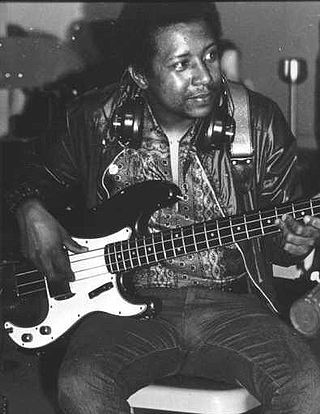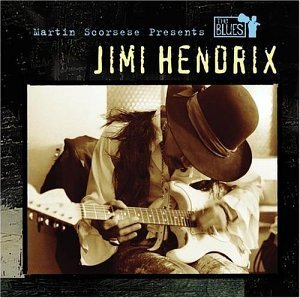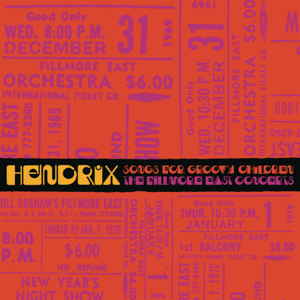
James Marshall "Jimi" Hendrix was an American guitarist, songwriter and singer. Although his mainstream career spanned only four years, he is widely regarded as the greatest and one of the most influential electric guitarists in the history of popular music, and one of the most celebrated musicians of the 20th century. The Rock and Roll Hall of Fame describes him as "arguably the greatest instrumentalist in the history of rock music."

Edwin H. Kramer is a South African-born recording producer and engineer. He has collaborated with several artists now in the Rock and Roll Hall of Fame, including Jimi Hendrix, the Beatles, David Bowie, the Rolling Stones, Led Zeppelin, Eric Clapton, the Kinks, Kiss, John Mellencamp, and Carlos Santana, as well as records for other well-known artists in various genres.
Roland Robinson was a longtime Memphis studio session bass player and songwriter. Robinson was a cousin and close friend of Teenie Hodges, Al Green's lead guitarist in the 1970s when Green recorded with the famed Hi Records staff band, the Hi Rhythm Section.
"Little Wing" is a song written by Jimi Hendrix and recorded by the Jimi Hendrix Experience in 1967. It is a slower tempo, rhythm and blues-inspired ballad featuring Hendrix's vocal and guitar with recording studio effects accompanied by bass, drums, and glockenspiel. Lyrically, it is one of several of his songs that reference an idealized feminine or guardian angel-like figure. At about two and a half minutes in length, it is one of his most concise and melodically focused pieces.

Band of Gypsys is a live album by Jimi Hendrix and the first without his original group, the Jimi Hendrix Experience. It was recorded on January 1, 1970, at the Fillmore East in New York City with Billy Cox on bass and Buddy Miles on drums, frequently referred to as the Band of Gypsys. The album mixes funk and rhythm and blues elements with hard rock and jamming, an approach which later became the basis of funk rock. It contains previously unreleased songs and was the last full-length Hendrix album released before his death six months later.

George Allen "Buddy" Miles Jr. was an American composer, drummer, guitarist, vocalist and producer. He was a founding member of the Electric Flag (1967), a member of Jimi Hendrix's Band of Gypsys (1969–1970), founder and leader of the Buddy Miles Express and later, the Buddy Miles Band. Miles also played and recorded with Carlos Santana and others. He also sang lead vocals on the California Raisins claymation TV commercials and recorded two California Raisins R&B albums.

Experience Hendrix: The Best of Jimi Hendrix is a compilation album of songs by American rock musician Jimi Hendrix, released in 1997 by MCA and reissued in 2010 by Legacy Recordings. The single compact disc collects 20 songs spanning his career, from his first recordings with the Jimi Hendrix Experience in 1966 to his last with Billy Cox and Mitch Mitchell in 1970.
"Red House" is a song written by Jimi Hendrix and one of the first songs recorded in 1966 by the Jimi Hendrix Experience. It has the musical form of a conventional twelve-bar blues and features Hendrix's guitar playing. He developed the song prior to forming the Experience and was inspired by earlier blues songs.

William "Billy" Cox is an American bassist, best known for performing with Jimi Hendrix. Cox is the only surviving musician to have regularly played with Hendrix: first with the experimental group that backed Hendrix at Woodstock, followed by the trio with drummer Buddy Miles that recorded the live Band of Gypsys album, and, lastly, The Cry of Love Tour trio with Mitch Mitchell back on drums. Cox continues to perform dates with the Band of Gypsys Experience and the Experience Hendrix Tour.

The Jimi Hendrix Experience is a box set by the British-American rock band the Jimi Hendrix Experience, released in 2000 by MCA. The material includes alternative recordings, live performances and some rarities. Although most of the material had been released in earlier compilations, some previously unreleased material was also included.

Martin Scorsese Presents the Blues: Jimi Hendrix is a ten track companion release to the critically acclaimed television documentary series Martin Scorsese Presents The Blues shown on PBS in September 2003.

"Angel" is a song by American rock musician Jimi Hendrix, featured on his 1971 posthumous studio album The Cry of Love. Written and self-produced by Hendrix, he recorded it for his planned fourth studio album just months before he died in September 1970.

Rainbow Bridge is a compilation album by American rock musician Jimi Hendrix. It was the second posthumous album release by his official record company and is mostly composed of recordings Hendrix made in 1969 and 1970 after the breakup of the Jimi Hendrix Experience. Despite the cover photo and subtitle Original Motion Picture Sound Track, it does not contain any songs recorded during his concert appearance for the 1971 film Rainbow Bridge.

Jimi Hendrix: An Illustrated Experience is a biography of American guitarist Jimi Hendrix, written by his stepsister Janie and his biographer John McDermott, and published on October 9, 2007. The book tells the story of Hendrix and his life through reproductions of rare material such as letters, drawings, postcards and posters. An Illustrated Experience also contains a companion CD entitled Hendrix: Live, which includes three live tracks, two interviews, and a studio jam entitled "Keep on Groovin'".
"Ezy Ryder" is a song written and recorded by American musician Jimi Hendrix. It is one of the few studio recordings to include both Buddy Miles on drums and Billy Cox on bass, with whom Hendrix recorded the live Band of Gypsys album (1970).
Leon Morris Hendrix is an American painter, songwriter, and musician. Although better known for his artwork, he began playing the guitar in 2002 and has since released multiple albums. He is the younger brother of legendary guitarist Jimi Hendrix.

Valleys of Neptune is a posthumous compilation album by the American rock musician Jimi Hendrix. Released in the United States on March 9, 2010, the album was promoted as having "12 previously unreleased studio recordings", including the title track, "one of the most sought after of all of Hendrix's commercially unavailable recordings".

Machine Gun: The Fillmore East First Show is a live album by Jimi Hendrix, featuring songs recorded during the first set at the Fillmore East in New York City on December 31, 1969. Hendrix is backed by Billy Cox on bass and Buddy Miles on drums, a lineup frequently referred to as the Band of Gypsys. Except for "Hear My Train A Comin'" and "Lover Man", the eleven songs represent new material that had not been performed by the Jimi Hendrix Experience.
"Hey Baby (New Rising Sun)" or simply "Hey Baby" is a song written and recorded by American musician Jimi Hendrix, from his second posthumous album Rainbow Bridge (1971). The song is a slower and more melodic piece, which features the prominent use of chorus- and tremolo-effects on guitar. Hendrix uses an idealized feminine figure that recurs in several of his lyrics. Commentators have seen the song as representative of his post-Band of Gypsys musical direction.

Songs For Groovy Children: The Fillmore East Concerts is a chronologically sequenced collection of American musician Jimi Hendrix's 1969–1970 New Years recorded performances at the Fillmore East in New York City. It was released as a box set of five-CDs on November 22, 2019 and an eight-LP set on December 13.














